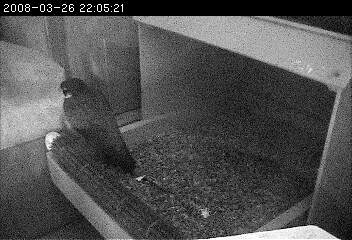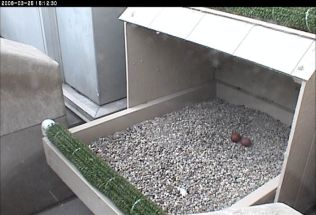 The Aviary’s webcam at the Pitt peregrine nest is so cool!
The Aviary’s webcam at the Pitt peregrine nest is so cool!
As of tonight the website is streaming live video so you can see the falcons in action from high atop the Cathedral of Learning.
The camera is so good you can even see the birds at night! Here’s a picture of Dorothy taken just after 10pm. (Click here to learn why she isn’t sitting on the eggs full time yet.)
To see the live stream, click on the picture or go directly to the Aviary’s webcam.
 March 25, 2008, 2:15pm: Dorothy laid her second egg on March 25 at about 2:15pm. Thanks to two sharp observers who sent me comments to alert me. It turns out that at 2:15pm I was outdoors watching the Cathedral of Learning. Suddenly Dorothy and Erie began a courtship flight. Maybe their flying meant “happy egg.”
March 25, 2008, 2:15pm: Dorothy laid her second egg on March 25 at about 2:15pm. Thanks to two sharp observers who sent me comments to alert me. It turns out that at 2:15pm I was outdoors watching the Cathedral of Learning. Suddenly Dorothy and Erie began a courtship flight. Maybe their flying meant “happy egg.”
.
.
.
This is really neat. I keep the website up on my computer and regularly check in. Just a thought: poor bird, how boring to sit hour after hour, day after day — no book to read or TV to watch to while away the time. How many days/weeks does she do this? And, I forget, does papa take over occasionally?
I’m glad I stumbled across your blog Kate. Thanks for the heads up on the falcon cam at Pitt. Great to see three of my favorite institutions intersecting on the subject of birds – Pitt, National Aviary WQED.
Answers to Libby’s questions:
How long does she incubate? The eggs usually hatch 38-40 days after the first one is laid and all within 24 hours or so. Since Dorothy starts incubating after the 3rd egg is laid that means she has 34-36 days of incubation ahead of her. I have often wondered how she copes with being so inactive. Since all mother birds go through this there may be a hormonal adjustment that helps.
Does papa take over occasionally? Yes! In the morning he goes hunting at dawn, brings her food and then takes over at the nest. After she’s eaten and flown a little she comes back & resumes incubation. You can sometimes tell who is who by size. He looks pretty small after you’ve gotten used to seeing her.
Can you tell anything about the origins of the new male based on his legbands? Are there marks on the bands to tell who banded him? Where he was banded, etc?
About how many falcons are known to be around the area?
So far (as of 4/15/08) we have only been able to see the color of the bands on the new male peregrine at Pitt. We haven’t been able to read the numbers. The colors indicate he was banded in the eastern US or Canada. That’s a HUGE area to choose from. We won’t know anything more until we can read the numbers on his bands.